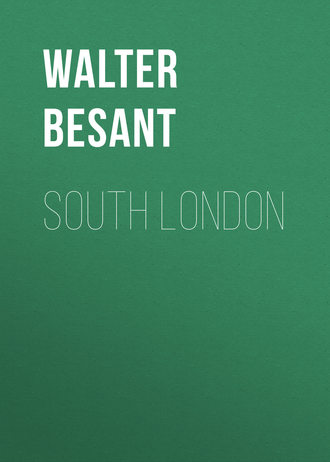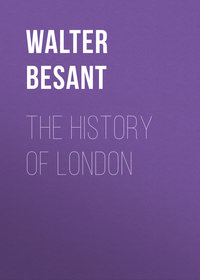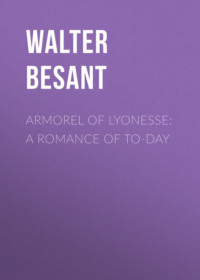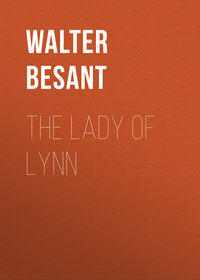 полная версия
полная версияSouth London
The Roman remains found up and down the place prove my assertion that the people who lived here were what we should call substantial. One need not catalogue the long list of Roman trouvailles; but, to take the more important, in the year 1819 there was discovered, in taking up the foundations of some old houses belonging to St. Thomas's Hospital, in St. Thomas's Street, a fine tesselated pavement, about ten feet below the surface of the ground. In the following year, in the area facing St. Saviour's Grammar School, seven or eight feet below the surface, there was found another, of a more elaborate design. Only a part of this was uncovered, as the Governors of the School forbade further investigation: it remains to this day still to be examined and unearthed, under the present potato and fruit market. At the entrance of King Street, at a depth of fifteen or sixteen feet, were found a great many Roman lamps, a vase, and other sepulchral deposits. And in tunnelling for a new sewer through Blackman Street and Snow Fields, in 1818 and 1819, and again in Union Street, in 1823, numerous Roman antiquities were discovered. In Trinity Square was found a coin of Gordianus Africanus. In Deverill Street, south of the Dover road, other coins were discovered; in St. Saviour's churchyard, a coin of Antoninus Pius. It has also been proved that an extensive Roman cemetery existed on the south of the ancient settlement. In the year 1840, when excavations were going on for the purpose of building a new wing to St. Thomas's Hospital, another tesselated pavement was disclosed, with passages and walls of other chambers, all built on piles, showing that the houses beside the causeway were thus supported in the marshy ground; Roman coins and pottery were also found here. Another pavement was discovered on the opposite side, south of Winchester Palace. On the river bank, at the corner of Clink Street, an ancient jetty was found; and in the new Southwark Street, deep down, groups of piles, pointed below, on which houses had been built. In many of the later buildings Roman tiles have been found. These remains are quite sufficient to prove that many wealthy people lived in Roman Southwark, and that they occupied villas built on piles beside the causeway.
Since, too, from the earliest times Southwark was famous for its inns, and since the same conditions prevailed in the fourth as in the fourteenth century, it is not unreasonable to suppose that the people who drove those long lines of packhorses laden with goods from London used Southwark as a place in which to deposit merchandise before taking it across the bridge; they halted in Southwark; they lodged in one of the inns: the place was most convenient for the City; storage was cheaper than on the river wharves; for strangers, the place was cheerful. In one respect, that of being a halting place and a lodging for traders, Southwark was like Thorney in its palmy days – a place of entertainment for man and beast. There was no forum here, as in Augusta; no place of meeting for merchants, such as Thames Street in Plantagenet times; there was no buying and selling, but there was continual coming and going, which made the place lively and cheerful.
Such were the origins of the settlements of South London. An embankment, a causeway, a fishery for the wants of Thorney first and of London next; then villas, put up by the better sort, attracted here, one believes, by the fresh air coming up the river with every tide, and by the quiet of the place. The settlement began quite early in the Roman occupation: this seems to be proved by the extent of the cemetery. The draining and drying of the low lands went on meanwhile gradually, gardens and orchards taking the place of the former marsh.
The place has always, save at rare intervals, been entirely defenceless. The Pax Romana protected it. Remember that London itself was not walled till the latter part of the fourth century. Why should it be? For more than three hundred years, for ten generations, the City knew no wars and feared no invader. The 'Count of the Saxon Shore' beat back, and kept back, the pirates of Norway and Denmark; the Legions beat back the marauders of Scotland and Ireland. Southwark, like the City its neighbour, needed no wall and asked for no defence.
Twice, before the arrival of the East Saxons, we get a glimpse in history of South London. The first is the rout of the usurper, the Emperor Allectus, after the battle of Clapham Common.
Towards the close of the third century the succession of usurpers who sprang up everywhere in the outlying portions of the Empire contained six who came from Britain. What effect these movements had upon the security of South London we have no means of learning. The history, however, of Carausius and his successor Allectus affords material for reflection. The former, who was of Belgian origin, rose to be the Count of the Saxon Shore – in other words, Admiral of the Roman Fleet. In this capacity he kept the seas free from pirates; enriched himself, became famous for his courage and his generosity; usurped the title of Cæsar, fought with and defeated the fleets of Maximian, and reigned in Britain for seven years. His headquarters were Boulogne and Southampton; near the latter place – at Bittern – is still seen the quay at which his ships were moored. His rule, of which we know little, was certainly strong and firm. Coins exist in great numbers of Carausius. They represent his arrival: 'Expectate, veni' – 'Come, thou long-expected!' Then his triumph: 'Shout IO ten times.' He held gladiatorial sports at London; he appointed a British senate. Then came the time when he must fight or die. Like the King of the Grove, the Usurper held his throne on that condition. Carausius, for some unknown reason, would not fight when the chance was offered – therefore he died. Another King of the Grove, Allectus by name, one of his officers, killed him and reigned in his stead. Then he, too, had to fight for crown and life. He accepted the challenge; he awaited with an army of Franks and Britons the arrival of the Roman forces sent to quell him: he awaited them in London. When the enemy drew near, he led out his men across the Bridge, and gave battle to the Roman general, Asclepiodotus, on the wild heath south of London, immediately beyond the rising ground – we now call the place Clapham Common – and there he fell bravely fighting. He had enjoyed the purple for three years. Perhaps, when he crossed the Bridge, conscious that he was going to meet his fate – either to continue an Emperor for another spell or to die – he reflected that for such a splendid three years' run it was worth while to risk, and even to lose, his life at the end.
This is, I say, the first glimpse we get of South London in history. We see the army marching across the Bridge and along the Causeway, shouting and singing. We see them a few hours later, flying from the field, rushing headlong over the Causeway, through the lines of villas to the Bridge. The terrified people, those who lived in the villas, are running over the Bridge after them. Once across the Bridge, the soldiers found that there was left in the City neither order nor authority. They therefore began to sack and pillage the rich houses, and to murder the inhabitants. Remember that all over the Roman Empire none were permitted to carry arms except the soldiers. Therefore there could be no defence. The pillage went on until the victorious general had got his army – or some of it – across the Bridge. How long it would take to bring up his troops, whether the Bridge was held by the Franks, whether the defeated army made any organised opposition, we know not. All we are told is that the Roman soldiers fought hand to hand with those of the dead Usurper in the streets of London, and that the latter were all massacred.
In the year 457 we get a second glimpse of Southwark in the flight of another defeated host. The Britons had gone forth to fight the Saxon invaders; they met the enemy – Hengist and Æsc his son – at 'Creeganford' – Crayford: they were defeated; four thousand of them were killed; they fled; they never stopped until they reached London Bridge; we can see them flying bareheaded, without weapons, along the Causeway and through the narrow gates of the Bridge. Alas! the old villas along the Causeway are deserted and in ruins; the place has been desolate for many years – since the Saxons began to swarm about the country; the former residents, if they are living still, are behind the walls; and their sons are carrying on the war which is to last two hundred long years, and to leave its memories of hatred behind it for fifteen hundred years at least. The gardens are grown over, the orchards are neglected, the inns are empty and ruinous.
Before long there falls the silence of death upon the walled City and the Bridge and the settlements of the South. All alike are deserted: the tide idly laps the piles of the rotting Bridge; it rolls along the empty wharves, bearing no keel upon its bosom; there is no boat on the river, there is no smoke from any house; there is no life, no sign of life, in the place which had formerly been so crowded and so busy. The timbered face of the embankment gave way and crumbled into the river; the Causeway was eaten by the tides here and there; the low grounds once more became a marsh, and the wild birds returned, undisturbed, to their former haunts.
I have elsewhere ('London,' ch. i.) described the natural reasons which led to this desertion of the City. It appears to us strange and almost impossible that a great city should be so utterly deserted. Where, however, are the cities of Tadmor, of Tyre, of Carthage? Where are the great cities of Asia Minor? The conqueror not only took the City and killed some of the people; he cut off the supplies, and therefore forced them to go. This was most certainly the case with London. Roger of Wendover, it is true, tells us that in the year 462 the Saxons took possession of London, and then successively of York, Lincoln, and Winchester, committing great devastation. 'They fell on the natives in every quarter, like wolves on sheep forsaken by their shepherds; the churches and all the ecclesiastical buildings they levelled with the ground; the priests they slew at the altars; the holy scriptures they burned with fire; the tombs of the holy martyrs they covered with mounds of earth; the clergy who escaped the slaughter fled with the relics of the saints to the caves and recesses of the earth, to the woods and deserts and the crags of the mountains.'
I do not suppose that Roger of Wendover (he died in 1237) had access to documents of the time. I would rather incline to the belief that, given certain undoubted facts of battle, murder, and sacrilege, he presented the world with a little embroidery of his own. An Assault on London is, however, possible; in which case the desertion of the City would be only hastened. With the ruin and desolation of Augusta came also the ruin of the southern settlement.
This silence – this desolation – lasted some hundred years. Then the men of Essex – the East Saxons – came down, a few at a time, and took possession of the deserted City; the merchants began timidly to bring their ships again with goods for trade; the East Saxons learned the meaning of bargains; Augusta was dead, but London revived. The City preserved its ancient name, but the southern settlement lost its name. We know not what the Romans or the Britons called it, but the Saxons called it Southwark. And they repaired the embankment and restored the ancient causeways, and cleared away the ruins.
Another point of difference: in London the new streets, laid out without rule or order, grew by degrees; they did not follow the old Roman streets, which were quite obliterated and utterly forgotten – one cannot imagine a more decisive proof of complete desertion and ruin. In Southwark, on the other hand, the streets remained the same – they were the two causeways and the embankment – because none others were then possible. High Street, Borough, is still, as it always has been, the ancient causeway connecting the new port of London with the Dover road.
Between the years 600 and 1000 Southwark suffered the vicissitudes which must happen in a period of continual warfare to an undefended suburb. In times of peace, when trade was possible, the place was what the Icelander Snorro Thirlesen calls an 'emporium.' All the merchandise carried to London from the south for export lay there waiting to be carried across the quays: the merchants themselves found accommodation there. But we cannot believe that when the Danish fleets brought their fierce warriors to the very walls of London, Southwark – or any other settlement – would continue to exist unfortified. That the place remained without a wall, except for certain temporary walls put up by the Danes, proves that it was regarded by itself as of small importance. This is also proved by another fact – namely, that the place was always occupied without defence. When, for instance, the Danes held London for twelve years, leaving it a wreck and a ruin, can we believe that any people remained in Southwark? In times of peace the fishermen lived here for greater convenience of their work; London by this time was impossible for them, because it was walled all along the river side. If peace was prolonged, inns were set up for the merchants: people built houses along the causeway. When war began again, and the enemy once more appeared, Southwark was again abandoned. This is the history of South London for a thousand years – alternate occupation and abandonment.
There exists a very singular heresy concerning Southwark. I would deal with it tenderly, because one, if not more, of the heretics is a personal friend of my own. It is that the site of the first or original London was on the South; that Roman London stood on the site of Southwark; and that, at some time or other, there was a transference of sites, the whole of Roman London migrating to the other side. It is even maintained that the name of Walworth proves that there was once a wall round the city of the south. To me the name of Walworth indicates the proximity of the high causeway running through its midst. The consideration of the site – the marshy, wet, and unwholesome site – is quite sufficient for me. At no time, not even in the time of the Lake dwellers, have marshes been selected by choice for the building of cities. Before the Embankment and the Causeway, the South of London was impossible for the residence of man.
The transference of sites is a theory often called in to account for, and make possible, other theories. Thus, the late James Fergusson invented the transference of sites in order to bolster up certain theories of his own on the Holy Places of Jerusalem. Here, however, there is no theory: only a statement by a geographer evidently ignorant of the boundaries of an obscure province of a district in a distant country which he had never seen. London, Ptolemy said, was in Kent. All the Roman remains, as we have seen, are found by the Causeway and the Embankment – there never could have been any wall; and, indeed, the only answer that is required to such a theory is to point to the natural conditions of the site. Is it conceivable that people would settle themselves in a marsh when they had firm and dry ground across the river?
CHAPTER II
EARLY HISTORY
Southwark, then, had no reason for existence at all except for its connection with London by bridge and ferry, and especially by bridge. Before the Ferry and the Bridge there was no Southwark. The history of Southwark is closely connected with the Bridge. It was on the south end of the Bridge that all the fighting took place, London very generously handing over her battles to her daughter of the south. I propose, in this chapter, to discourse about the Bridge and one or two of its earlier battles.
It is sometimes stated, confidently, that before the Bridge there was the Ferry. Why? To carry people across the river and 'dump' them down in the marsh? But people had no business in the marsh. First came the Bridge and the Causeway to connect it with the Dover road. Then traffic began to cross the Bridge and to meet the Dover road. But as yet there was no ferry. Then came the Embankment, and the appearance of houses along the Causeway and on the Embankment. As the trade of London increased, so Southwark – I would we had the Roman name – increased in proportion. Inns were created for the convenience of merchants, trade was drawn from Thorney on the south by the Bridge, just as it was diverted on the north by the military way connecting the great high road with London. When the Causeway was always filled with caravans and long trains of heavily laden packhorses; when the inns were crowded with merchants and their slaves; when the Bridge was all day covered with passengers and carriers; then the Ferry was demanded as a quicker and an easier way of getting across. Two Ferries, there were; perhaps more. One of these ran from Dowgate Dock to St. Mary Overies; the other crossed the river lower down, nearer the Tower. So things remained for nearly two thousand years – say, from A.D. 100 to A.D. 1750. If a man wanted to get across the river, he did not make his way to London Bridge, and painfully walk across amid the carriers and the caravans, the plunging horses and the droves of oxen; he stepped into the boat and was ferried across. We must not look on the Bridge as a means of getting across the river for the people: it was not; it was the means of conveying merchandise to and fro; it was a construction most important for military purposes; it was a barrier to prevent a hostile fleet from getting higher up the river; but, for the ordinary passenger, the boat was the quicker and the easier means of conveyance.
When was the Bridge built? It is impossible to say. It was not there A.D. 61, when Queen Boadicea's troops sacked the City and murdered the people. It was there when Allectus led his troops out to fight the Roman legions. It was there very early in the Roman occupation, as is proved by the quantities of Roman coins of the four centuries of their tenure found in the bed of the river on the site of the old Bridge. It is also proved by the fact that Southwark was a settlement of the wealthier class, who could not have lived in a place absolutely without supplies, had there been no bridge. We may take any time we please for the construction of the Bridge, so long as it is quite early – say, before the second century.
The building of the Bridge can be arrived at with such great certainty that I have no hesitation in presenting a drawing of it. As this Bridge has never before been figured by the pencil of any artist, it will be well for me to indicate the steps by which its reconstruction has been made possible.
The Britons themselves were quite unable to construct a bridge of any kind, unless in the primitive methods observed at Post Bridge and Two Bridges, on Dartmoor, by a slab of stone laid across two boulders. The work, therefore, was certainly undertaken by Roman engineers. We have, in the next place, to inquire what kind of bridge was built at that time by the Romans. They built bridges of wood and of stone; many of these stone bridges still remain, in other cases the pieces of hewn stone still remain. The Bridge over the Thames, however, was of wood. This is proved by the fact that, had it been of the solid Roman construction in stone, the piers would be still remaining; also by the fact that London had to be contented with a wooden bridge till the year 1176, when the first bridge of stone was commenced. Considerations as to the comparative insignificance of London in the first century, as to the absence of stone in the neighbourhood, and as to the plentiful supply of the best wood in the world from the forests north of the City, confirm the theory that the Bridge was built of wood. We have only, therefore, to learn how Roman engineers built bridges of wood elsewhere, in order to know how they built a bridge of wood over the Thames. And this we know without any doubt.
First: they drove piles into the bed of the river – not upright piles, but inclined at an angle; they placed two piles side by side, and opposite to these two more; they connected the two piles by ties and the opposite piles with them by transverse girders. Across them they laid a huge beam – a tree roughly hewn, and across these beams they laid the floor of stout planks. The weight of beams and planks and the parapet put up afterwards, with perhaps other planks for greater safety, pressed down the piles and held them in place. To prevent the current from carrying them away, each double pair of piles was protected by a 'starling,' formed by driving upright smaller piles in front at the piers and enclosing a space, which was filled up with stones, so that the force of the current was not felt by the great piles.
In this way the Roman Bridge was built. You will understand it better from the drawing, which shows the Bridge taken from the Embankment near the present site of St. Mary Overies Church. The gate is the river-gate in the long straight wall which ran along the bank of the river. The wall, it is obvious, must have been pierced at several points for the convenience of trade and the quays: one supposes that these posterns could be easily closed and defended. This river-wall, we shall presently see, was standing in the time of Cnut. Some parts of it stood until the building of the stone Bridge in the last quarter of the twelfth century. The Roman Bridge was also the Saxon Bridge, the Danish Bridge, and the Norman Bridge.
In course of time the river-wall was removed, bit by bit: its foundations still lie under the pavement and the warehouses. The gate was altered. I do not suppose there was much of the original structure left when the East Saxons took possession of the City after a hundred years of desertion and decay. But a gate of some kind there must always have been. The breadth of the Bridge allowed, according to FitzStephen, two carts to pass each other. That means about sixteen feet. Like the very ancient stone bridges of Saintes and Avignon, the Bridge was from sixteen to twenty feet broad. The river-gate stood at the south end of Botolph Lane, some seventy feet east of the present Bridge: the second Bridge – the first of stone – stood between the first and third, having St. Magnus' Church on the north and St. Olave's on the south side; together with its own chapel of St. Thomas on the Bridge itself, to place it under the special protection of the saints most dear to London hearts.
The Bridge, and especially the south end of it, was a field of battle whenever the way of war came near to London. The first glimpse, as we have seen, which we catch of it is when Allectus and his forces crossed the river by the Bridge to give battle to the legions of Asclepiodotus on the Heath beyond the rising ground. A few hours later, on the same day, their columns routed, their general dead, we see the defeated troops once more flying across the narrow Bridge. There was no one to lead them, or they could have held the Bridge against all comers; there was no drawbridge to pull up, or they could have kept the Romans out by that expedient. One wonders if all their officers were lying dead on the field, with Allectus, for the troops, who were Franks for the most part, seem to have left the Bridge without a guard, and the river-gate wide open, while they melted into little companies, who ran about the City pillaging the houses and murdering the unfortunate people.
By the Roman law the people were unarmed: no one could carry arms except the soldiers. The law was a safeguard against rebellion; but it opened the door to military revolts, and it destroyed the military spirit among the civil population – always a most dangerous thing for a State. The Roman legions poured into the City; they found Allectus' Franks at their murderous work, and they cut them down. If it is true, as stated by the historians, that they were all cut off to a man, London must have been a horrible shambles.
The second glimpse of the Bridge is also that of a routed army flying across the narrow way to seek shelter between the walls. It is in the year 467. They are the Britons flying from their defeat in Kent. After this there is silence – absolute silence, leaving not so much as a whisper, a tradition, or a legend; the silence that can only mean desertion – silence for a hundred and fifty years.
When London reappears, it is in humble guise: the City has shrunk within her ancient walls; and these have fallen into decay. Southwark no longer exists. We learn that the Bridge has been repaired, because there is easy communication with Canterbury. Yet in the Danish troubles there is no fighting on or for the Bridge. Why? simply because there were no defenders of the Bridge on the south. In 819 and in 857 the Danes entered London and 'slaughtered numbers,' apparently without opposition. In 872 they occupied London, apparently without opposition. We hear of no siege, of no fighting on the Bridge; of no shelter behind the walls. Yet there was a defence at York, at Reading, at Nottingham – behind the walls. Why not in London? Because in London the walls, 5,500 yards in length, had become too long to man, or to defend, or to repair. The Danes ran into the City through the shattered gate; they leaped over the broken wall. What happened to the people; what street fighting was carried on, what slaughter, what plunder, what horrible treatment of women – we may understand from the page of the historian Saxo relating other sacks and sieges by the gentle Dane. As for the trade, the wealth, the name and fame of London – they all perished together. It was a ruined city, with a miserable population of craftsmen enslaved by the Dane, that Alfred reconquered. The Bridge itself was broken down; the settlements of the south were deserted: even the fishermen had left the Thames above and below London, and sought for safety in the retired creeks and safe backwaters along the coast of Essex. The London fisherman sallied forth in his coracle from the marshes behind Canvey Island, and from the slopes of Hadleigh. Alfred repaired the walls and the Bridge and rebuilt the gates. Something like peace was restored to the City and order to the country. Then trade, which welcomes the first appearance of safety, began again. If the merchant feared the pirates of the Foreland, he could march across the Bridge to Dover; or he could land at Dover and march across Kent to the Bridge. Then the old settlements on the south Causeway were rebuilt and new inns sprang up, and Southwark began again.











